Themed collection Peptide Soft Materials

Introduction to peptide soft materials
Arindam Banerjee and Ian W. Hamley introduce the Soft Matter themed collection on peptide soft materials.

Soft Matter, 2020,16, 9998-10000
https://doi.org/10.1039/D0SM90212H
Amyloids and their untapped potential as hydrogelators
Amyloid fibrils are cross-β-sheet-rich fibrous aggregates. The fibrils can entangle to form a 3-dimensional network that can eventually turn into hydrogel, with or without specific triggers.
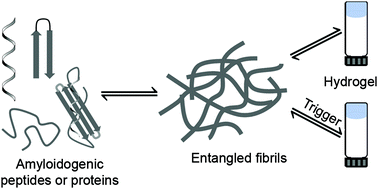
Soft Matter, 2020,16, 10013-10028
https://doi.org/10.1039/D0SM01578D
Low molecular weight self-assembling peptide-based materials for cell culture, antimicrobial, anti-inflammatory, wound healing, anticancer, drug delivery, bioimaging and 3D bioprinting applications
This article emphasizes on the rational design and development of self-assembling peptide-based materials for cell culture, antimicrobial, anti-inflammatory, anticancer, wound healing, drug delivery, bioimaging and 3D bioprinting applications.
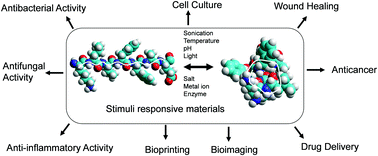
Soft Matter, 2020,16, 10065-10095
https://doi.org/10.1039/D0SM01136C
Exploring the properties and potential biomedical applications of NSAID-capped peptide hydrogels
This review summarises the work published by our research group, alongside other research groups, on supramolecular hydrogels consisting of short peptides conjugated to non-steroidal anti-inflammatory drugs (NSAIDs).

Soft Matter, 2020,16, 10001-10012
https://doi.org/10.1039/D0SM01198C
Recent trends in the development of peptide and protein-based hydrogel therapeutics for the healing of CNS injury
This review article represents an overview of peptide and protein based hydrogel therapeutics as a gradually emerging excellent tissue engineering scaffold as well as drug delivery dais to treat severe CNS injury and its associated complications.
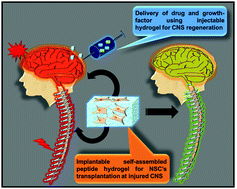
Soft Matter, 2020,16, 10046-10064
https://doi.org/10.1039/D0SM00885K
Recent advances in the fabrication, functionalization, and bioapplications of peptide hydrogels
The structural and functional tailoring of peptide hydrogels promotes their bio-related applications.
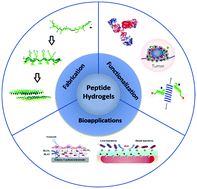
Soft Matter, 2020,16, 10029-10045
https://doi.org/10.1039/D0SM00966K
Affinity-based thermoresponsive fluorescence switching of proteins conjugated with a polymer-binding peptide
Affinity-based thermoresponsive fluorescence switching of proteins conjugated with a polymer-binding peptide is demonstrated. Specific affinity of the peptide and thermoresponsive structural transitions of the polymer are essential for the switching.

Soft Matter, 2020,16, 10096-10100
https://doi.org/10.1039/D0SM01107J
The ratio of hydrogelator to precursor controls the enzymatic hydrogelation of a branched peptide
Here, we report an apparently counterintuitive observation, in which a lower volume fraction of a branched peptide forms a stronger hydrogel after an enterokinase (ENTK) cleaves off the branch from the peptide.
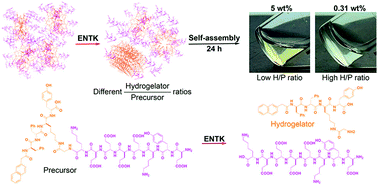
Soft Matter, 2020,16, 10101-10105
https://doi.org/10.1039/D0SM00867B
Aggregation propensity of therapeutic fibrin-homing pentapeptides: insights from experiments and molecular dynamics simulations
CREKA (Cys–Arg–Glu–Lys–Ala) and its engineered analogue CRMeEKA, (N-methyl-Glu instead of Glu), are emerging pentapeptides that were specifically designed to bind fibrin–fibronectin complexes accumulated in the walls of tumour vessels.
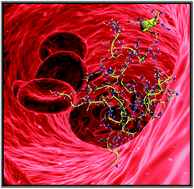
Soft Matter, 2020,16, 10169-10179
https://doi.org/10.1039/D0SM00930J
Impact of gelation method on thixotropic properties of phenylalanine-derived supramolecular hydrogels
Supramolecular hydrogels formed by noncovalent self-assembly of low molecular weight (LMW) agents are promising next-generation biomaterials.
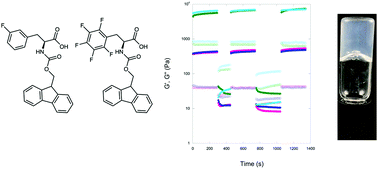
Soft Matter, 2020,16, 10158-10168
https://doi.org/10.1039/D0SM01217C
Supramolecular hydrogels from unprotected dipeptides: a comparative study on stereoisomers and structural isomers
Unprotected dipeptides are studied for self-assembly into hydrogels and single-crystal XRD data reveal key insights in the supramolecular interactions.
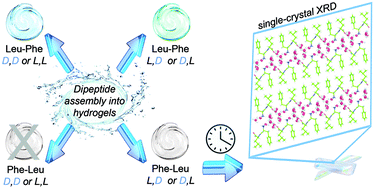
Soft Matter, 2020,16, 10151-10157
https://doi.org/10.1039/D0SM01191F
Time matters for macroscopic membranes formed by alginate and cationic β-sheet peptides
The peptide age and membrane geometry affect the micro- and nano-structure of hierarchically ordered planar and spherical membranes constructed at the interface of cationic β-sheet peptides and alginate solution.
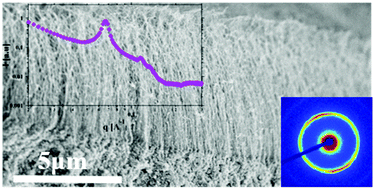
Soft Matter, 2020,16, 10132-10142
https://doi.org/10.1039/D0SM01197E
Effects of fluoro substitutions and electrostatic interactions on the self-assembled structures and hydrogelation of tripeptides: tuning the mechanical properties of co-assembled hydrogels
A series of FFK tripeptides capped with phenylacetic acid of various fluoro-substitutions at the N-terminus has been synthesized and examined for self-assembly under aqueous conditions.
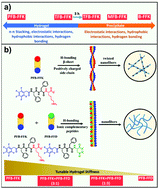
Soft Matter, 2020,16, 10143-10150
https://doi.org/10.1039/D0SM01186J
A spectroscopic and molecular dynamics study on the aggregation process of a long-acting lipidated therapeutic peptide: the case of semaglutide
The aggregation of semaglutide was followed from the early time steps to the late formation of mesoscopic dendrimeric structures.
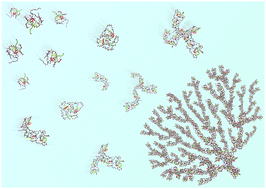
Soft Matter, 2020,16, 10122-10131
https://doi.org/10.1039/D0SM01011A
Acid-responsive fibrillation and urease-assisted defibrillation of phenylalanine: a transient supramolecular hydrogel
A mimic of living systems has been achieved by the acid-responsive assembly and urease-assisted disassembly of fibrils from benzyloxycarbonyl-L-phenylalanine, leading to a transient supramolecular hydrogel.

Soft Matter, 2020,16, 10115-10121
https://doi.org/10.1039/D0SM00774A
The aging effect on the enhancement of thermal stability, mechanical stiffness and fluorescence properties of histidine-appended naphthalenediimide based two-component hydrogels
Two-component hydrogels show remarkable advancement in thermal and mechanical stabilities, and fluorescent intensity upon an unusual aging effect.
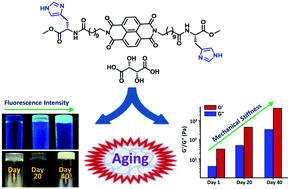
Soft Matter, 2020,16, 10106-10114
https://doi.org/10.1039/D0SM00468E
Bi-functional peptide-based 3D hydrogel-scaffolds
Over the last few years, hydrogels have been proposed for many biomedical applications, including drug delivery systems and scaffolds for tissue engineering.
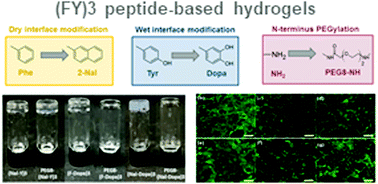
Soft Matter, 2020,16, 7006-7017
https://doi.org/10.1039/D0SM00825G
Directed self-assembly of peptide–diketopyrrolopyrrole conjugates – a platform for bio-organic thin film preparation
Increased water solubility and long-range intermolecular ordering have been introduced into the fluorescent organic molecule thiophene-diketopyrrolopyrrole via its conjugation to the octapeptide HEFISTAH, derived from a protein–protein β-interface.
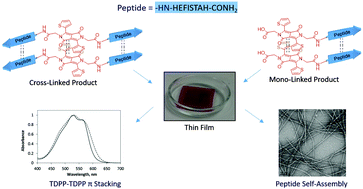
Soft Matter, 2020,16, 6563-6571
https://doi.org/10.1039/D0SM01071E
Self-assembly and intracellular delivery of DNA by a truncated fragment derived from the Trojan peptide Penetratin
A heptamer containing the longest noncationic amino acid sequence of Penetratin is shown to form peptiplexes with DNA. The structure is characterized from molecular to nanoscopic scale and peptiplexes are shown to assist intracell delivery of DNA.

Soft Matter, 2020,16, 4746-4755
https://doi.org/10.1039/D0SM00347F
Polymorphism of asymmetric catalysts based on amphiphilic lipopeptides in solution
The self-assembly of model [P]RWG lipopeptides (P: L-proline, R: L-arginine, W: L-tryptophan, G: L-glycine), containing one or two aliphatic octadecyl (C18) chains in water and cyclohexanone/water solutions was examined. The enantiomeric selectivity was found to be related to the assembly of catalyst molecules.
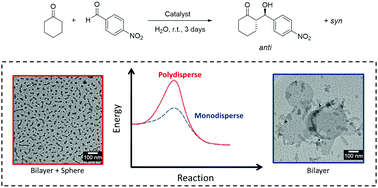
Soft Matter, 2020,16, 4615-4624
https://doi.org/10.1039/D0SM00245C
Chemical stimulus-responsive supramolecular hydrogel formation and shrinkage of a hydrazone-containing short peptide derivative
Herein, we describe a short peptide derivative containing a hydrazone bond showing transient hydrogel formation triggered by hydrazone–oxime exchange reaction.
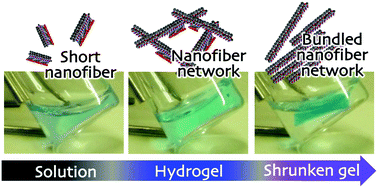
Soft Matter, 2020,16, 899-906
https://doi.org/10.1039/C9SM01969C
About this collection
This special issue, Guest Edited by Arindam Banerjee, Indian Association for the Cultivation of Science, and Ian Hamley, University of Reading, focuses on peptide soft materials in their broadest sense and covers the development of peptide soft materials such as peptide-based hydro- and organo-gels, nanostructured peptide biomaterials, emulsions and capsules.
The issue presents examples of the diverse applications of soft matter peptide systems as responsive materials for diagnostics, therapeutics and remediation with particular relevance to new biomedical applications. It also discusses state-of-the-art examples of novel peptide hybrid systems, in which peptides are combined (covalently or in mixture formulations) with polymers, lipids, polysaccharides and nucleic acids.